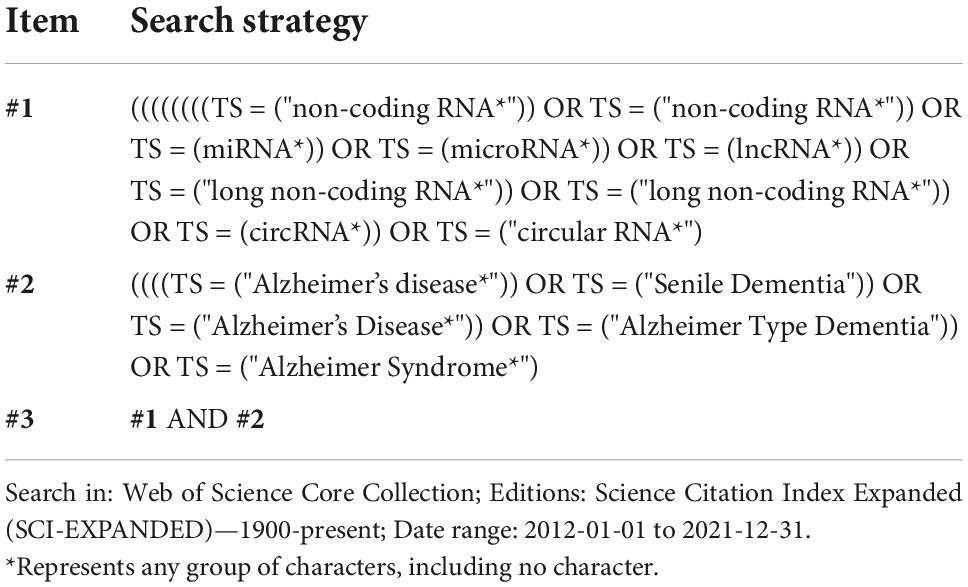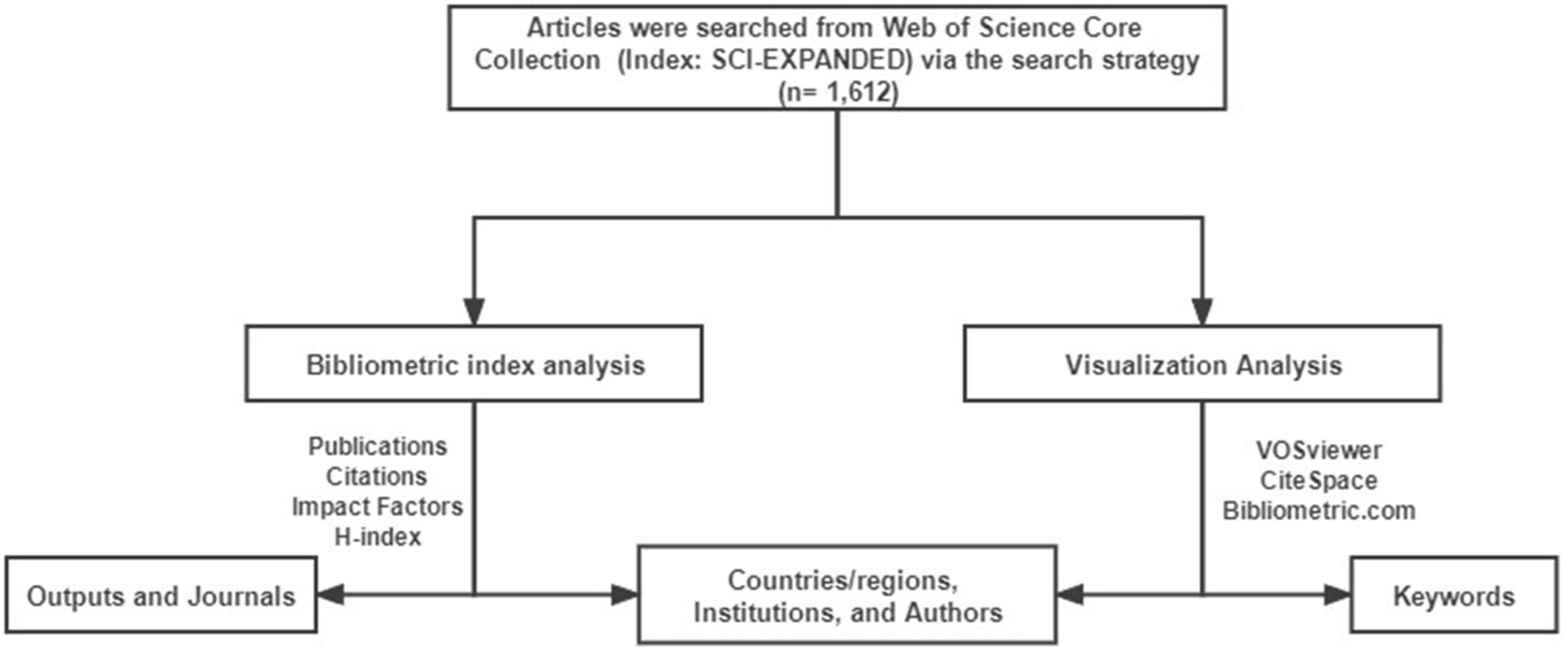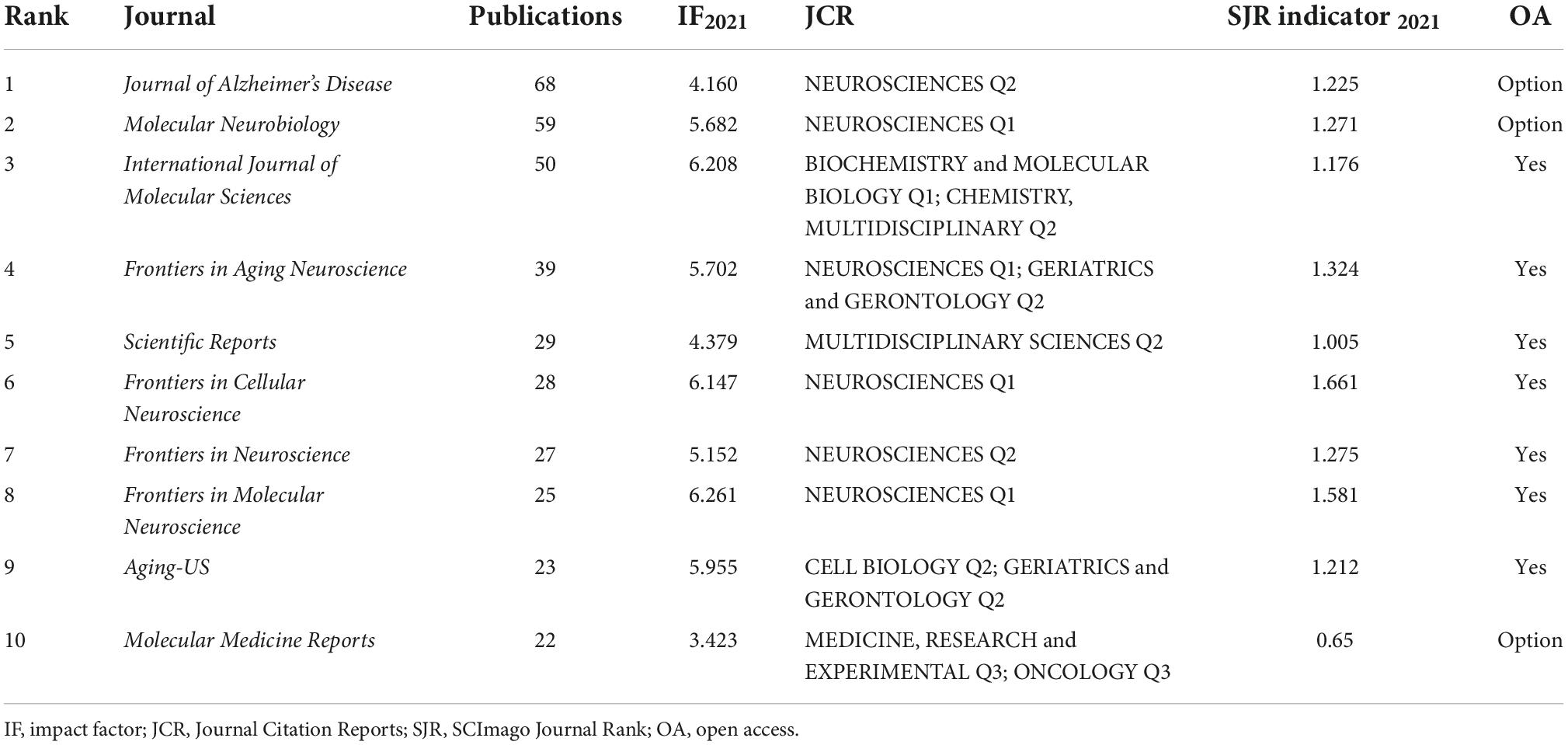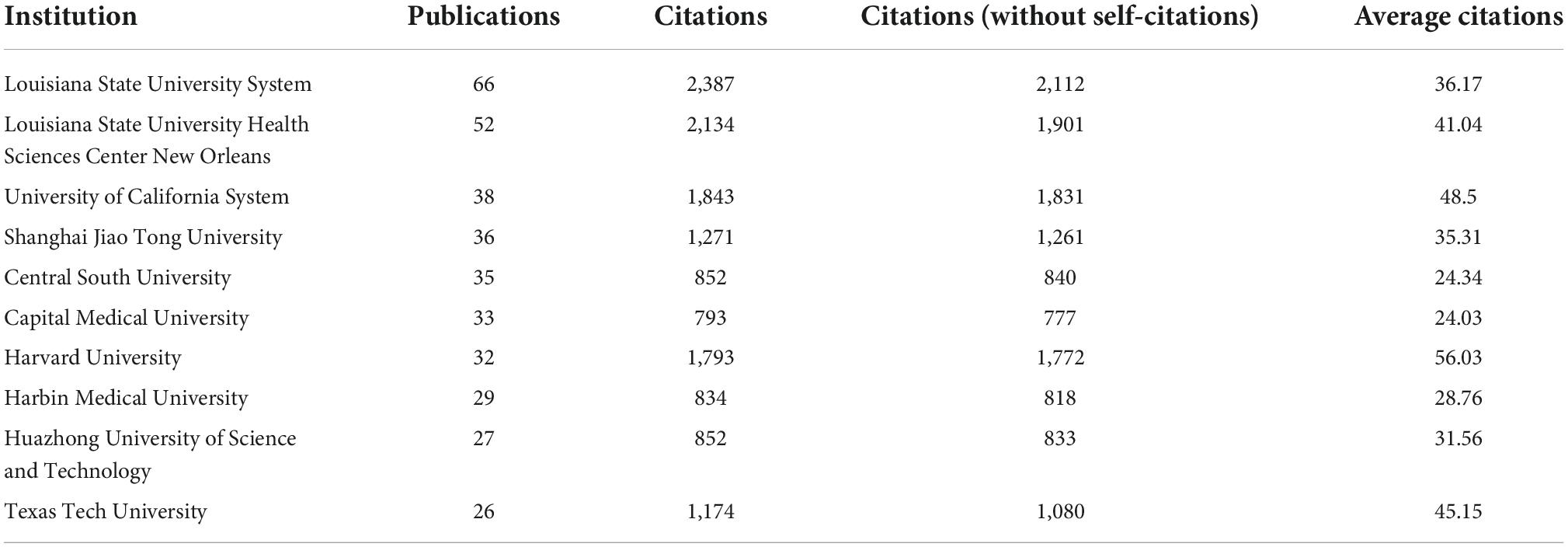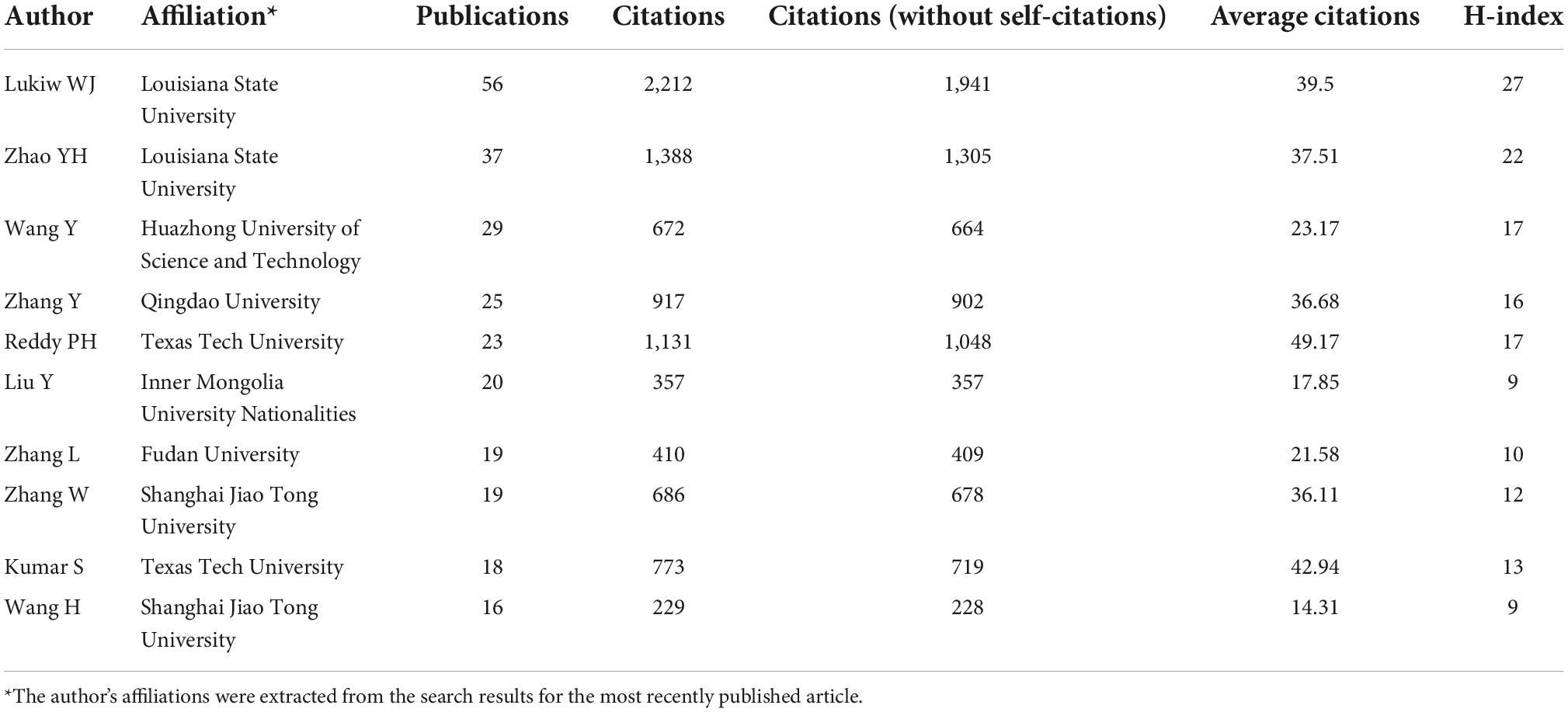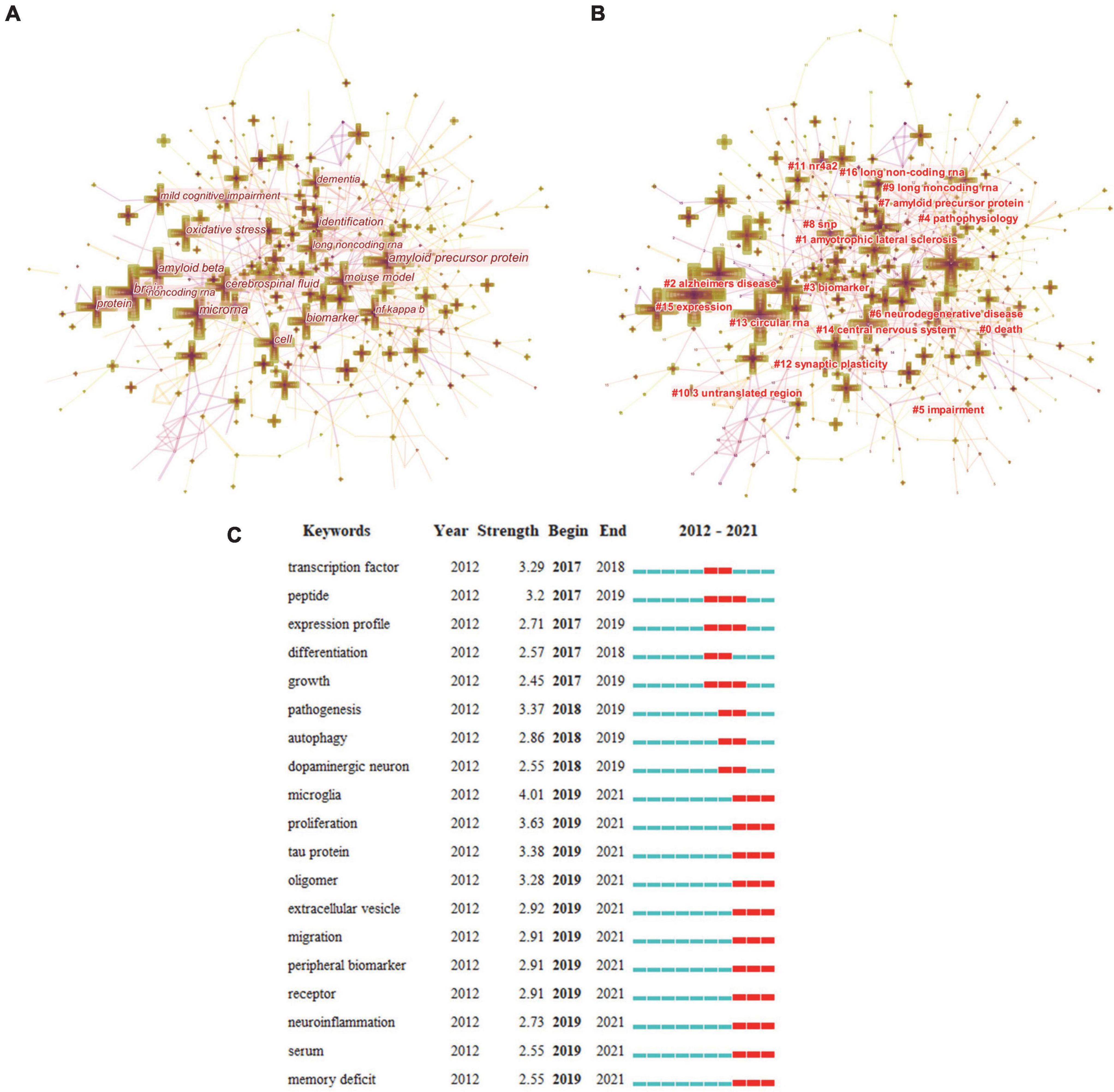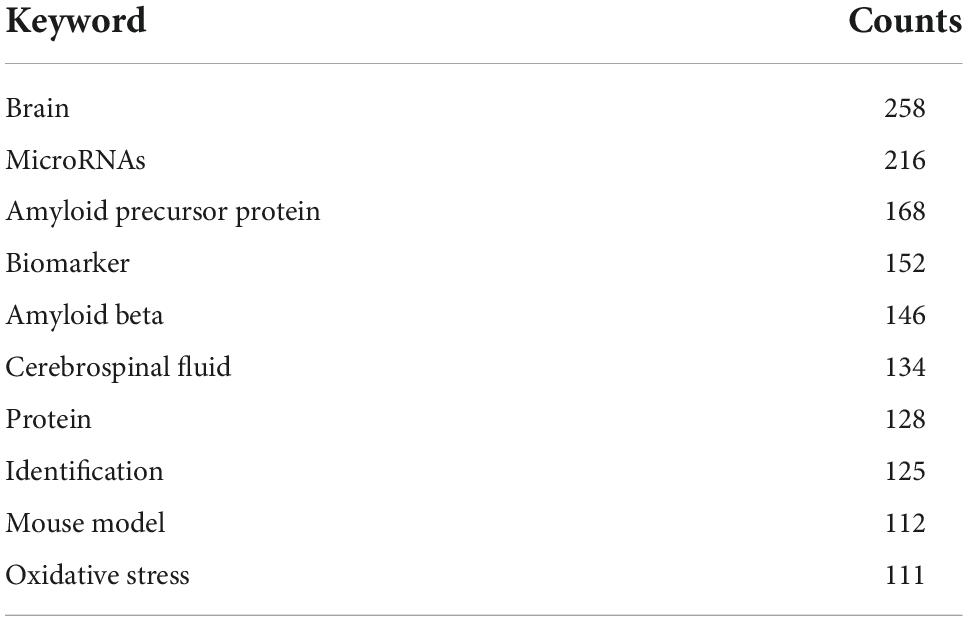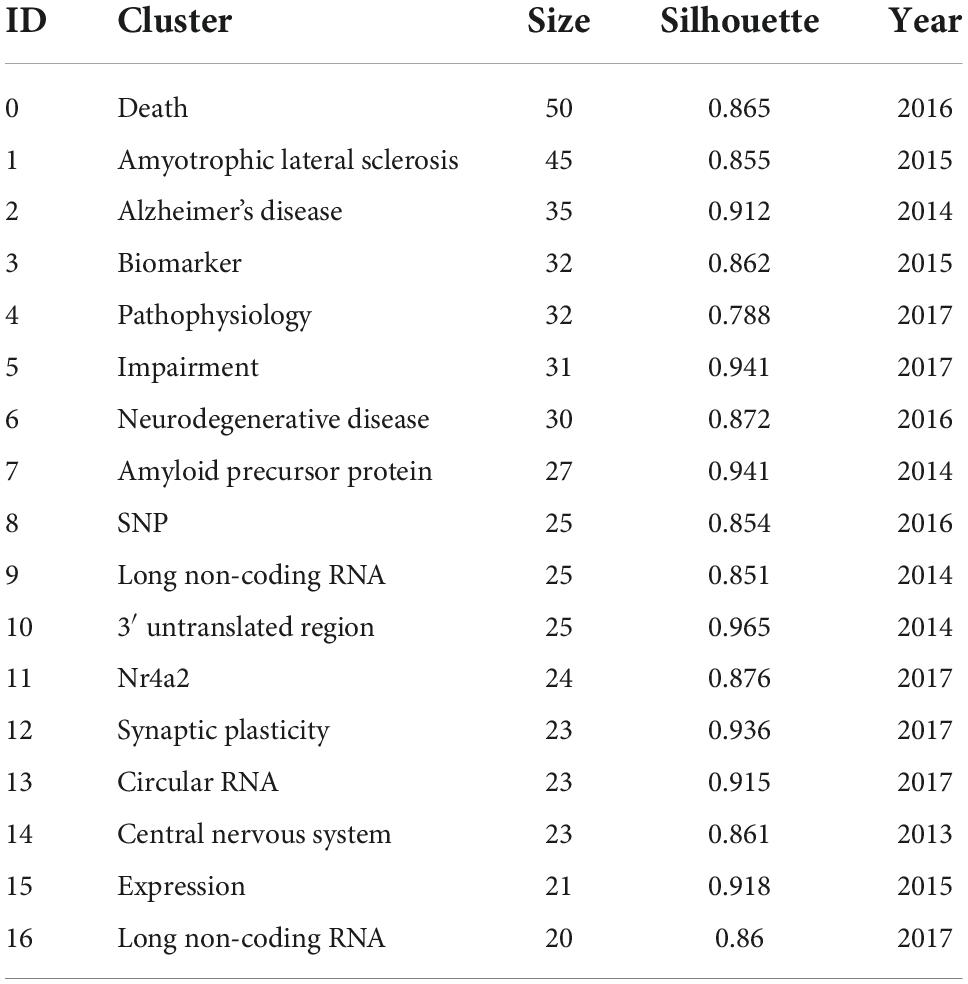- 1Department of Psychiatry, Chengdu Eighth People’s Hospital (Geriatric Hospital of Chengdu Medical College), Chengdu, China
- 2Rehabilitation Medicine Center and Institute of Rehabilitation Medicine, West China Hospital, Sichuan University, Chengdu, China
- 3Key Laboratory of Rehabilitation Medicine in Sichuan Province, Chengdu, China
- 4Department of Rehabilitation Medicine, The Affiliated Hospital of Southwest Medical University, Luzhou, China
- 5Department of Rehabilitation Medicine, The First Affiliated Hospital of Chengdu Medical College, Chengdu, China
Background: Non-coding RNAs (ncRNA) are a kind of RNA that does not encode protein, which play an important role in Alzheimer’s disease (AD). However, there is a lack of bibliometric analysis and visualization analysis of the research related to AD and ncRNAs.
Materials and methods: Literature related to AD and ncRNAs in the last decade were searched through the Web of Science Core Collection (WOSCC). The relevant information from all the searched articles was collected. The bibliometric visualization website, CiteSpace, and VOSviewer were used for visualization analysis of countries/regions, institutions, authors, and keywords.
Results: In total, 1,613 kinds of literature were published in the field. Literature in this field were published in 494 journals. The Journal of Alzheimer’s Disease was the most popular journal. China, Louisiana State University System, and Lukiw WJ were the countries/regions, institutions, and authors with the highest scientific productivity, respectively. The research hotspots in this field focused on the role and mechanism of ncRNAs, especially microRNAs, in AD. The level of research was mainly based on basic research, focusing on animal and cellular levels, and related to proteomics. “Circular RNAs,” “regulation of neuroinflammation,” and “tau protein” were the future research directions.
Conclusion: Taken together, the field of AD and ncRNAs is developing well. The research hotspots and frontiers in this field can provide a reference for researchers to choose their research direction.
Introduction
Alzheimer’s disease (AD) is a neurodegenerative disease with insidious onset, characterized by progressive cognitive dysfunction and memory impairment (Morató et al., 2022). The main pathological features of AD are decreased a number of cortical neurons, nerve fiber tangles, and senile plaque deposition (Counil and Krantic, 2020; Tran et al., 2022). With the increase of age, the incidence of AD increases gradually, which seriously affects the quality of life and brings a great burden to families. At present, AD has become an important public health problem (Clark et al., 2022; Wang Q. et al., 2022).
Non-coding RNAs (ncRNAs) are a kind of RNA that does not encode protein, which play an important role in tumor, cardiovascular and nervous system diseases (Wang S. et al., 2022). For example, it has been reported that nuclear paraspeckle assembly transcript 1 (NEAT1) lncRNA, an ncRNA, can be used as a potential blood-based biomarker for AD (Khodayi et al., 2022). Indeed, the role of ncRNAs in nervous system diseases has been further refined, and in-depth studies on the physiological functions of a specific ncRNA have gradually shown a potential correlation with AD (Jiang et al., 2022). For example, miR-143-3p has been found to inhibit abnormal Tau phosphorylation in AD and amyloid processing in amyloid precursor protein (Wang L. et al., 2022).
Bibliometrics can analyze the research trend in a particular field in a certain period time (Wang et al., 2020). Through the quantitative and qualitative analysis of the literature in the field via mathematical and statistical methods, the research hotspots and research frontiers can be revealed (Fei et al., 2022; Zhang Z. et al., 2022). Moreover, bibliometrics has played a crucial role in neurology, psychiatry, cardiovascular disease, and many other disciplines. Besides, data visualization tools such as CiteSpace and VOSviewer have also been widely used in bibliometric analysis (Zhang Y. et al., 2022).
With the deepening of research, new ncRNAs have been continuously isolated and identified, and increased research have been conducted to explore the relationship between AD and ncRNAs in the past 10 years. However, up to now, there is a lack of bibliometric analysis and visualization analysis of the research related to AD and ncRNAs. Thus, our study searches the literature related to AD and ncRNAs in the last decade through the Web of Science Core Collection (WOSCC), aiming to reveal the research trends, research hotspots, and frontiers in this field via the means of bibliometric analysis.
Materials and methods
Search strategy
The specific search strategy is shown in Table 1. The search was completed independently by two researchers on August 21, 2022, and then bibliometric analysis and visual analysis were carried out after the search results were consistent. The specific process is shown in Figure 1.
Data collection and bibliometric index statistics
The relevant information of all the searched articles was exported, and the bibliometric indicators were counted by Excel, including the annual number of publications, citation frequency, average citation frequency, journal name, journal impact factor (IF), SCImago Journal Rank (SJR) Indicator, publication country/region, publication institution, author, and author’s H-index.
Visualization analysis
The map of countries/regions cooperation was made by the bibliometric visualization website1. The maps of institutions’ cooperation and authors’ cooperation were made by VOSviewer (Version 1.6.16). Considering that research hotspots and frontiers are an important part of the bibliometric analysis in a professional field, it is of great significance to summarize and discuss the research hotspots in this field. Therefore, when analyzing keywords, we used CiteSpace (Version V5.8.R3) software to conduct co-occurrence, clustering, and burst analysis of keywords. The original data of all search results used for visualization analysis have been uploaded to Supplementary Data Sheet 1. And the parameter settings of each visualization tool have been uploaded to Supplementary Data Sheet 2.
All the above steps were completed by two researchers independently. When the results of data processing were inconsistent, a third researcher intervened and a unified result was obtained after discussion. The content of the discussion included whether the search strategy (punctuation, date range, database selection, etc.) and the format of the exported data were correct, as well as whether the parameters selection of visualization tools was consistent.
Results
Outputs and journals
Totally, 1,613 kinds of literature were published in the field of AD and ncRNAs in the last decade, among which article and review accounted for 70 and 24% of all document types, respectively (Figure 2A). By the end of the search date (August 28, 2022), the total citations reached 50,937, with an average of 31.6 citations per literature.

Figure 2. Document type distribution (A) and publications/citations situation (B) in the field of AD and ncRNAs in the past decade.
We summarized the annual publications and citations of literature in this field in the past 10 years (Figure 2B). With time, the number of literatures published increased year by year. The period from 2012 to 2016 is a stage of slow growth, with an average of 93.4 literature published per year. The period from 2017 to 2021 is a stage of rapid growth, with an average of 229 kinds of literature published per year. The citations also increased with time, and the increase rate of citations increased significantly after 2018.
Literature in this field were published in 494 journals, and we summarized the top 10 journals (Table 2). The journal with the largest number of articles was the Journal of Alzheimer’s Disease, with a total of 68 articles, followed by Molecular Neurobiology (n = 59) and International Journal of Molecular Sciences (n = 50). The IF of all journals was over 3.000. Five journals had an IF of more than 5.000, and their Journal Citation Reports (JCR) area was in Q1. In addition, the journal with the highest SJR indicator was Frontiers in Cellular Neuroscience (1.661), followed by Frontiers in Molecular Neuroscience (1.581), and Frontiers in Aging Neuroscience (1.324).
Countries/regions
Researchers from 68 countries/regions published literature in this field. Among them, the country with the largest number of publications was China, with a total of 632 publications, followed by the United States (n = 446) and Italy (n = 102) (Table 3). From 2012 to 2015, the annual publications in the United States were very large. After 2016, the annual publications in China exceeded that of the United States, ranking first. The annual publications in Italy, Germany, and Canada were relatively small, but tended to be stable (Figure 3A). When we re-ranked the 10 countries according to the average citations, the top three countries were Canada (average citations = 45.42), Germany (average citations = 44.93), and the United States (average citations = 42.3). Moreover, although China had the largest number of publications, the number of countries/regions cooperating with China was fewer than that of the United States and Germany (Figure 3B). Particularly, the United States had the most cooperation in this field. In addition, Italy, Germany, and Canada, which rank third to fifth in terms of total publications, were also important nodes on the map of international cooperation.
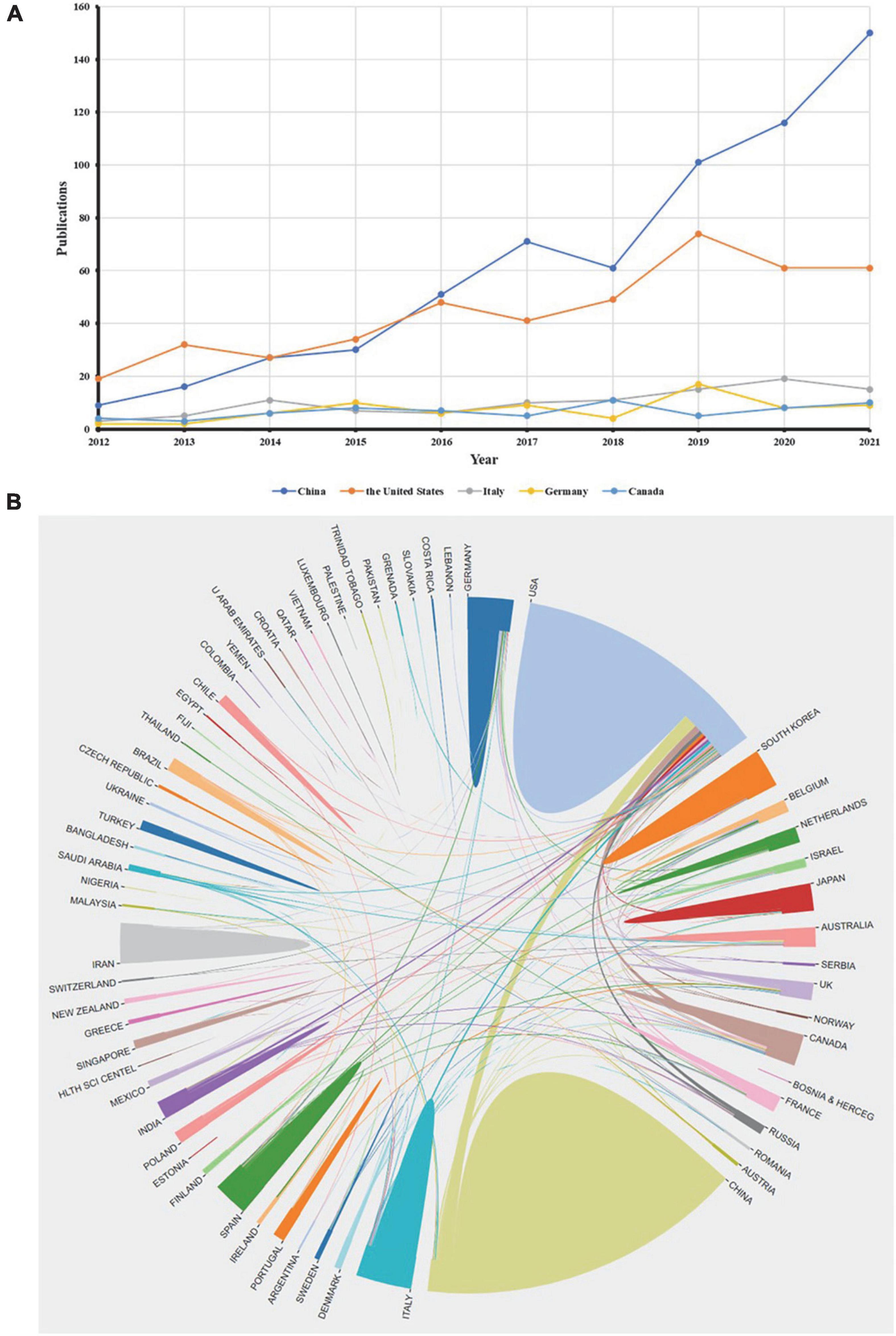
Figure 3. Countries/regions analysis in the field of AD and ncRNAs in the past decade. (A) The annual publications of the top five countries. (B) Cooperation among countries/regions in the field.
Institutions
Researchers from a total of 1,843 institutions published literature in this field. We listed the top 10 institutions with the most published literature (Table 4). Louisiana State University System is the institution with the largest number of publications, with a total of 66 publications, followed by Louisiana State University Health Sciences Center New Orleans (n = 52) and the University of California System (n = 38). The institution with the highest average citation was Harvard University (average citations = 56.03) and followed by the University of California System (average citations = 48.5) and Louisiana State University Health Sciences Center New Orleans (average citations = 48.5).
The maps of institutions’ cooperation in the field of AD and ncRNAs are shown in Figure 4A, which consisted of 311 projects, 18 clusters, 950 links, and 1,321 total link strength. In terms of the number of links, Louisiana State University System had the largest number of links, with 58 lines, indicating the most cooperation with other organizations in this field, followed by Shanghai Jiao Tong University (link = 46) and Boston University (link = 34).
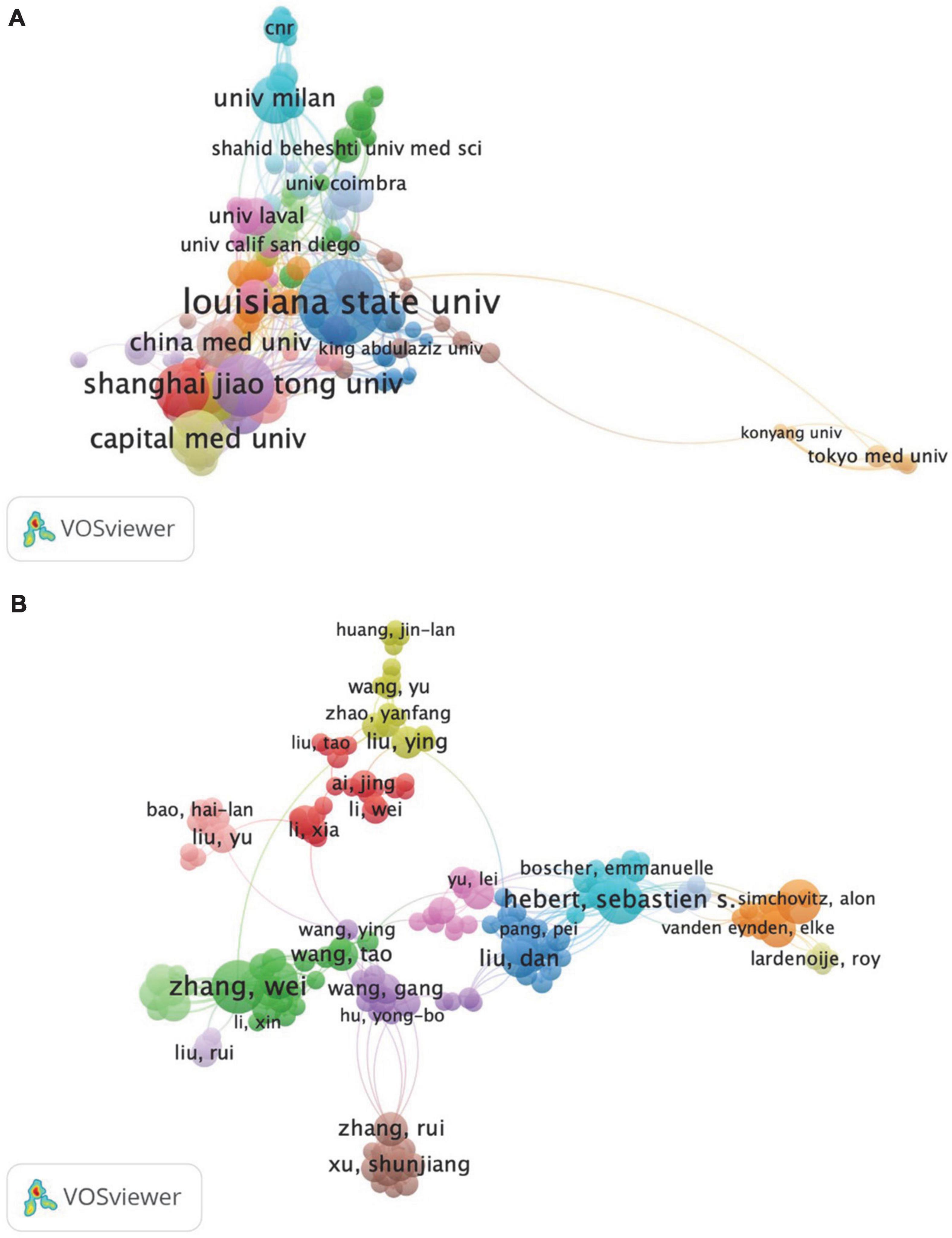
Figure 4. The map of institutions’ cooperation (A) and authors’ cooperation (B) in the field of AD and ncRNAs in the past decade.
In addition, we found that Brigham and Women’s Hospital, Broad Institute, Diamir, LLC, Harvard University, and the University of Pennsylvania were associated with one cluster. Moreover, Biorchestra Co., Ltd., Griffith University, Konyang University, Meiji Pharmaceut University, Nagoya University, National Cancer Center Hospital, National Center for Geriatrics and Gerontology, RIKEN Center for Integrative Medical Sciences, Tokyo Medical University, University of South Pacific, and the University of Tokyo were related to another group with a long-distance.
Authors
A total of 7,237 authors have published literature in this field, and the top three authors were Lukiw WJ (n = 56), Zhao YH (n = 37), and Wang Y (n = 29) (Table 5). The total citations of Lukiw WJ reached 2,212, and the average citation was 39.5. In addition, Lukiw WJ’s H-index reached 27, which was the author with the highest H-index in this field. Moreover, Reddy PH was the author with the highest average citations, up to 49.17, followed by Kumar S (average citations = 42.94) and Lukiw WJ (average citations = 39.5).
A visual analysis of the cooperation map between authors with three or more publications was performed using VOSviewer (Figure 4B). The principal researchers of the cooperation map were Lukiw WJ (Documents = 54, Citations = 2207, Total link strength = 117), Zhao YH (documents = 37, citations = 1390, total link strength = 108), Zhang W (documents = 19, citations = 689, total link strength = 76) and Hebert, SS (documents = 15, citations = 838, total link strength = 60). Other researchers were related to one of these lead researchers. Within the cooperation network, 14 major author clusters could be distinguished. Among them, the red cluster had the most collaborators, including Ai J, Liu Y, Yang Hui, Gao Y, Zhang Y, and Li W, followed by the green cluster and blue cluster.
Keywords
CiteSpace was used to analyze keywords in the field of AD and ncRNAs. We deleted words such as expression, gene-expression and RNA that did not affect the subsequent analysis. CiteSpace was used to conduct a co-occurrence analysis of keywords (Figure 5A). A total of 494 nodes, 802 links were generated in the map of keywords co-occurrence, and we listed the top 10 co-occurrence keywords (Table 6). A total of 17 clusters were obtained by keyword cluster analysis (Figure 5B and Table 7), which had high credibility (the Silhouette value of each cluster was greater than 0.7). Besides, the burst analysis found that the burst words in the past 5 years (Figure 5C).
Discussion
Non-coding RNAs play an important role in AD and are being explored by researchers in various countries. Through the methods of bibliometric and visual analysis, our study summarizes the research trends and hotspots, analyzes the cooperation in the field, and predicts the direction of future research in this field.
High scientific research outputs and high-quality journals
In the field of AD and ncRNAs, review and article account for more than 94% of all document types, especially article accounts for more than 70%. The number of research outputs is increasing year by year, indicating that the field is developing well. Of note, from 2012 to 2016, the average annual number of publications in this field was fewer than 100. With the accumulation of relevant research basis, the average annual number of articles published from 2017 to 2021 has exceeded 200. Therefore, 2017 can be seen as an important inflection point for the rapid development of this field. This also indicates that since 2017, more and more studies have focused on ncRNAs. Moreover, the total citations of articles have increased sharply since 2018. This may be attributed to the gradual accumulation of previous studies, leading more and more researchers to pay attention to this field.
Journal analysis can provide effective references for the publication of research results. The Journal of Alzheimer’s Disease is a professional journal on AD and the most popular journal in this field, suggesting that researchers prefer to publish their findings in professional journals. In addition to the number of publications, publication quality is also one metric, and the SJR indicator can better help researchers find high-quality journals in their field (Falagas et al., 2008). In general, the SJR indicator has a certain positive correlation with journal impact factors. The more highly cited articles in the journal, the more likely they are to be cited by other prestige journals (Yuen, 2018). In the field of AD and ncRNAs, the top 10 journals with the most publications are almost high-quality journals. Among them, Frontiers in Cellular Neuroscience, Frontiers in Molecular Neuroscience, and Frontiers in Aging Neuroscience are good choices for the majority of researchers to publish relevant research results. Different from the previous bibliometric analysis, we summarize whether the journal is an Open Access (OA) journal (Benita, 2021; Li et al., 2021). OA journals can significantly increase the citations of literature because they provide a wider global readership than any subscription-based journal. In the top 10 journals, almost all journals offer OA options, which is also one of the trends in literature publication in recent years.
Cooperation needs to be strengthened
Most of the previous studies show that the United States has the highest scientific productivity in many fields (Wang et al., 2020; Yao et al., 2020). Until 2016, the United States was ahead of any other country in annual publications, and since then, China has surpassed the United States in annual publications. However, China is the country that has the highest scientific productivity in this field. Unfortunately, China’s average citations are almost at the bottom among the top 10 countries/regions with the most publications, which means that China still lacks some influence in this field. Although the United States ranks second in scientific productivity, its literature has high average citations. Meanwhile, the United States has a lot of cooperation with other countries, which means that it is still the influential research country in this field.
In addition, the results of the institutions analysis show that most of the research in this field is still concentrated in scientific research institutions in the United States, which indirectly indicates that China’s institutions that publish scientific research outputs are relatively scattered and lack cooperation. Similar results can also be obtained through the Visualization analysis of VOSviewer. Few institutions have published high-cited research in China, and there is a lack of international cooperation. Besides, we further summarized the top 10 authors and analyzed the cooperation between the authors who published more than 3 articles. Among the authors with high scientific productivity, Chinese authors account for a large proportion. More importantly, Chinese authors with high productivity carry out more cooperation, but they still focus on domestic cooperation and lack of international cooperation.
Objects with high scientific productivity and influence in the field can be identified through the analysis of countries/regions, institutions, and authors. Through visualization analysis, the cooperation among them can be determined. Cooperation with producers (authors, institutions, countries/regions) with high publications is indeed an effective way for some producers where scientific research is in its infancy or early stages, and may help to increase the output and impact of scientific research. Additionally, the development of international cooperation is more conducive to the improvement of scientific research output, which needs to be strengthened in most countries, including China.
The highly cited articles are instructive
Articles with high citations often have important reference value, and sometimes they may be key articles that can lay the foundation for a certain field (Cheng et al., 2022; Li Y. et al., 2022). The most cited article in this field is “Amyloid beta: structure, biology and structure-based therapeutic development” published by the research team of Chen et al. (2017). They review the role of Amyloid beta in AD. More importantly, they have mentioned that ncRNAs, especially microRNAs (miRNAs), have become a potential therapeutic target of AD, which boosts researchers’ confidence in exploring the relationship between AD and ncRNAs.
Besides, Lukiw WJ, the author with the highest scientific productivity, published “Deficiency in the Ubiquitin Conjugating Enzyme UBE2A in Alzheimer’s disease (AD) is Linked to Deficits in a Natural Circular miRNA-7 Sponge (circRNA; ciRS-7),” which is widely cited (Zhao et al., 2016). This article indicates that the occurrence of AD is related to the lack of ciRS-7. Of note, Reddy PH, the author with the highest average citations, published “Are circulating microRNAs peripheral biomarkers for Alzheimer’s disease?”, which is also worthy of attention (Kumar and Reddy, 2016). They reveal some promising candidates for miRNAs, such as miR-9, miR-125b, and let-7g-5p, and discuss their diagnostic features and cellular functions. These findings provide a basis for finding potential biomarkers of AD. From these highly cited articles, it can be found that ncRNAs play an important role in the diagnosis and treatment of AD and are expected to become a diagnostic biomarker and therapeutic target.
Research hotspots and frontiers
Keywords co-occurrence analysis to preliminarily identify the hotspots in the field
The analysis of keywords co-occurrence can preliminarily identify the research hotspots in this field. The co-occurrence frequency of “brain,” “microRNAs,” “amyloid precursor protein,” “biomarker,” “amyloid beta,” “cerebrospinal fluid,” “protein,” “identification,” “mouse model,” and “oxidative stress” are all over 100. These results illustrate that the hotspots of research in this field are mainly focused on the role and mechanism of ncRNAs, especially miRNAs, in AD. And the level of research is mainly based on basic research, focusing on animal and cellular levels, and related to proteomics.
Indeed, such results are also in line with the current overall research trend in this field. It is well known that amyloid precursor protein and amyloid-beta are critical to the occurrence and development of AD. Anti-amyloid therapy is also a popular strategy in the treatment of AD in recent years (Brucki et al., 2022). More importantly, some ncRNAs can attenuate amyloid-induced neurotoxicity by targeting certain proteins. For example, miR-431 can protect amyloid-beta-induced nerve damage by inhibiting the expression of Kremen1 (Ross et al., 2018). Moreover, the latest study also found that inhibiting the expression of miR-26a-5p can up-regulate the expression of its target PTGS2, thereby alleviating amyloid-beta-induced nerve damage (Xie et al., 2022).
In addition, the two keywords “identification” and “cerebrospinal-fluid” have also attracted our attention. In recent years, most research on the role of ncRNAs from different sources in AD have been published. In fact, ncRNAs are not only found in nerve cells but can also be detected in blood and cerebrospinal fluid, suggesting that ncRNAs from different tissue may have different clinical significance (Nikolac Perkovic et al., 2021; Doroszkiewicz et al., 2022). In fact, the expression level of ncRNAs in different tissues may also be different, which also makes it difficult to explore biomarkers for AD. For example, compared with normal controls, the expression of hsa-miR-16-5p in peripheral blood samples is not significantly different, but significantly increases in cerebrospinal fluid (Asadi et al., 2022; Sandau et al., 2022).
Keywords cluster analysis to further identify the hotspots in the field
We used CiteSpace to divide these keywords into 17 clusters. The smaller the cluster number, the more keywords it contains. Through cluster analysis, the keywords can be better summarized and classified, and the research hotspots in this field can be better understood. At present, the research hotspots in this field are still focused on “death,” “amyotrophic lateral sclerosis,” “Alzheimer’s disease,” “biomarker,” “pathophysiology,” “impairment,” “neurodegenerative disease,” “amyloid precursor protein,” “single nucleotide polymorphisms (SNP),” “long non-coding RNA,” “3′ untranslated region,” “Nr4a2,” “synaptic plasticity,” “circular RNA,” and “central nervous system.”
“Alzheimer’s disease” and “amyotrophic lateral sclerosis” belong to neurodegenerative diseases of the central nervous system, and they have some similar pathogenesis (Almikhlafi et al., 2022; Li S. H. et al., 2022). Thus, it is not surprising that these labels can be formed after keyword clustering analysis. On the contrary, it is “death” that arouses our interest as the largest cluster in the field. We know that neurodegeneration is accompanied by nerve cell death, and anti-nerve cell death is one of the strategies for the treatment of AD (Liang and Wang, 2022). More importantly, ncRNAs can play a role in the regulation of nerve cell death, and ncRNAs are expected to become another therapeutic target for AD. It has been found that down-regulation of miR-22 can significantly alleviate the apoptosis of PC-12 cells induced by LPS and achieve the purpose of treating diseases (Wang Y. et al., 2022). Of course, there are many types of nerve cell death, including apoptosis, pyroptosis, necrosis, and ferroptosis (He et al., 2022; Jin et al., 2022; Mangalmurti and Lukens, 2022). Whether ncRNAs can achieve the purpose of treating diseases by regulating different types of death is also worthy of further study in the future (Li W. et al., 2022; Wang J. et al., 2022).
It is worth mentioning that the cluster “Nr4a2” has also attracted our attention. It has been reported that the transcriptional factor nuclear receptor 4A subfamily (Nr4a) is involved in a variety of physiological processes in the hippocampus, from inflammation to neuroprotection, and may become a new synaptic therapy target for AD (Català-Solsona et al., 2021). More importantly, ncRNAs may also regulate Nr4a to play a role in the treatment of AD (Annese et al., 2018; Zhang et al., 2021). For example, some studies have found that miR-409-3p activates the NF-κB pathway by targeting Nr4a2, which promotes neuroinflammation (Hu et al., 2021). Therefore, regulating the expression of ncRNAs can achieve the purpose of regulating related target proteins, which is also one of the hotspots concerned by researchers in this field.
Keywords burst analysis identify the frontiers in the field
We summarize the burst keywords in the past 5 years, in which the burst of “microglia,” “proliferation,” “tau protein,” “oligomer,” “extracellular vesicle,” “migration,” “peripheral biomarker,” “receptor,” “neuroinflammation,” “serum,” and “memory deficit” continued until 2021. These burst keywords may be trends for future research. For example, neuroinflammation, as a common phenotype in the pathological state of nerve cells, has been paid more and more attention. And revealing the regulatory mechanism of ncRNAs in AD from the perspective of neuroinflammation can provide new ideas for the treatment of AD (Lan et al., 2021; Zingale et al., 2021). A recent review article also shows that ncRNAs in exosomes can mediate nerve inflammation and promote the development of AD (Weng et al., 2022). In addition, memory deficits are the main characteristics of AD, and improving memory deficits by regulating ncRNAs is also a future research direction (Ju et al., 2021; Xiao et al., 2021; Zhang G. J. et al., 2022).
In short, through the keyword burst analysis, we can objectively predict the future research hotspots and guide researchers to choose the future research direction. The results of burst analysis are friendly to the emerging research team, and these different topics, such as the application of circular RNAs from different tissue sources in AD, the regulation of neuroinflammation, and tau protein, can be a good choice for these teams.
Strengths and limitations
Previous bibliometric analysis related to AD have been published, such as intestinal flora and AD, epilepsy and AD, and brain energy metabolism disorder in AD (Du et al., 2021; Trejo-Castro et al., 2022; Zhang G. F. et al., 2022). These studies have revealed the research hotspots and frontiers in different subfields of AD. However, to the best of our knowledge, our study is the first bibliometric analysis in the field of AD and ncRNAs. The data involved in our study are all extracted from the Web of Science, and the extracted data are comprehensive, reliable, and highly recognized. A large number of previous bibliometric analysis have also used this database (Yao et al., 2020; Sun et al., 2022; You et al., 2022).
However, there are some limitations to our study. Our search strategy may not be able to retrieve all kinds of literature in this field, which is an inherent limitation of bibliometrics. As there is no restriction on the document types of literature, some authors may not publish research article, but mainly publish document type of review or letter, which may produce misleading results on contributions in this field, but this is unavoidable in bibliometric analysis (Zhu et al., 2021). Besides, the searched authors may have the same name or the change of their institutions, which may lead to bias in the results. In addition, as the year 2022 has not yet ended, it is impossible to accurately analyze the research hotspots of this year, so our bibliometrics does not include the literature published in 2022, but only discusses them. Therefore, we believe that the citations of the latest publications should be further analyzed in the future.
Conclusion
Taken together, the field of AD and ncRNAs is developing well. Journal of Alzheimer’s Disease is a professional journal on AD and the most popular journal in this field. China is the country with the highest scientific productivity, but its scientific research influence needs to be improved. The United States has carried out the most international cooperation and remains the most influential country in the field. Louisiana State University System is the institution with the highest scientific productivity. Lukiw WJ is the most influential author. The research hotspots in this field focus on the role and mechanism of ncRNAs, especially miRNAs, in AD. The level of research in the field is mainly based on basic research, focusing on animal and cellular levels, and related to proteomics. Circular RNAs, regulation of neuroinflammation, and tau protein are the future research directions.
Data availability statement
The original contributions presented in this study are included in the article/Supplementary material, further inquiries can be directed to the corresponding author/s.
Author contributions
YG and YH contributed to the study conception and design and revised the manuscript. XF, SW, and JL performed the literature search and data analysis. XF, SW, QZ, and YG wrote the first draft of the manuscript. All authors listed have made a substantial contribution to the work, read, and approved the final manuscript.
Funding
This work was supported by school-level scientific research project of Southwest Medical University (Grant No. 2021ZKQN042). The funders had no role in study design, data collection and analysis, decision to publish or preparation of the manuscript.
Conflict of interest
The authors declare that the research was conducted in the absence of any commercial or financial relationships that could be construed as a potential conflict of interest.
Publisher’s note
All claims expressed in this article are solely those of the authors and do not necessarily represent those of their affiliated organizations, or those of the publisher, the editors and the reviewers. Any product that may be evaluated in this article, or claim that may be made by its manufacturer, is not guaranteed or endorsed by the publisher.
Supplementary material
The Supplementary Material for this article can be found online at: https://www.frontiersin.org/articles/10.3389/fnagi.2022.1037068/full#supplementary-material
Abbreviations
AD, Alzheimer’s disease; circRNAs, circular RNAs; IF, impact factor; JCR, Journal Citation Reports; lncRNAs, long non-coding RNAs; miRNAs, microRNAs; ncRNAs, non-coding RNAs; NEAT1, nuclear paraspeckle assembly transcript1; Nr4a, nuclear receptor 4A subfamily; SJR, SCImago Journal Rank; SNP, single nucleotide polymorphisms.
Footnotes
References
Almikhlafi, M. A., Karami, M. M., Jana, A., Alqurashi, T. M., Majrashi, M., Alghamdi, B. S., et al. (2022). Mitochondrial medicine : A promising therapeutic option against various neurodegenerative disorders. Curr. Neuropharmacol. 20. doi: 10.2174/1570159X20666220830112408
Annese, A., Manzari, C., Lionetti, C., Picardi, E., Horner, D. S., Chiara, M., et al. (2018). Whole transcriptome profiling of late-onset Alzheimer’s disease patients provides insights into the molecular changes involved in the disease. Sci. Rep. 8:4282. doi: 10.1038/s41598-018-22701-2
Asadi, M. R., Talebi, M., Gharesouran, J., Sabaie, H., Jalaiei, A., Arsang-Jang, S., et al. (2022). Analysis of ROQUIN, tristetraprolin (TTP), and BDNF/miR-16/TTP regulatory axis in late onset Alzheimer’s disease. Front. Aging Neurosci. 14:933019. doi: 10.3389/fnagi.2022.933019
Benita, F. (2021). Human mobility behavior in COVID-19: A systematic literature review and bibliometric analysis. Sustain. Cities Soc. 70:102916. doi: 10.1016/j.scs.2021.102916
Brucki, S. M. D., César-Freitas, K. G., Spera, R. R., Borges, C. R., and Smid, J. (2022). Are we ready to use anti-amyloid therapy in Alzheimer’s disease? Arq. Neuro Psiquiatr. 80, 15–23.
Català-Solsona, J., Miñano-Molina, A. J., and Rodríguez-Álvarez, J. (2021). Nr4a2 transcription factor in hippocampal synaptic plasticity, memory and cognitive dysfunction: A perspective review. Front. Mol. Neurosci. 14:786226. doi: 10.3389/fnmol.2021.786226
Chen, G. F., Xu, T. H., Yan, Y., Zhou, Y. R., Jiang, Y., Melcher, K., et al. (2017). Amyloid beta: Structure, biology and structure-based therapeutic development. Acta Pharmacol. Sin. 38, 1205–1235.
Cheng, K., Guo, Q., Shen, Z., Yang, W., Zhou, Y., Sun, Z., et al. (2022). Frontiers of ferroptosis research: An analysis from the top 100 most influential articles in the field. Front. Oncol. 12:948389. doi: 10.3389/fonc.2022.948389
Clark, E., Faruque, S., Mutebi, C., Nagirimadugu, N. V., Kim, A., Mahendran, M., et al. (2022). Investigating the relationship between mild traumatic brain injury and Alzheimer’s disease and related dementias: A systematic review. J. Neurol. 269, 4635–4645. doi: 10.1007/s00415-022-11186-9
Counil, H., and Krantic, S. (2020). Synaptic activity and (Neuro)inflammation in Alzheimer’s disease: Could exosomes be an additional link? J. Alzheimers Dis. 74, 1029–1043. doi: 10.3233/JAD-191237
Doroszkiewicz, J., Groblewska, M., and Mroczko, B. (2022). Molecular biomarkers and their implications for the early diagnosis of selected neurodegenerative diseases. Int. J. Mol. Sci. 23:4610.
Du, Y. H., Yang, R. Y., Wang, Q., Wang, L. Y., Liang, L. C., Zhu, L., et al. (2021). Bibliometric analysis study on the mechanisms of brain energy metabolism disorders in Alzheimer’s disease from 2000 to 2020. Front. Neurol. 12:670220. doi: 10.3389/fneur.2021.670220
Falagas, M. E., Kouranos, V. D., Arencibia-Jorge, R., and Karageorgopoulos, D. E. (2008). Comparison of SCImago journal rank indicator with journal impact factor. FASEB J. 22, 2623–2628.
Fei, X., Zeng, Q., Wang, J., Gao, Y., and Xu, F. (2022). Bibliometric analysis of 100 most-cited articles in delirium. Front. Psychiatry 13:931632. doi: 10.3389/fpsyt.2022.931632
He, D. L., Fan, Y. G., and Wang, Z. Y. (2022). Energy crisis links to autophagy and ferroptosis in Alzheimer’s disease: Current evidence and future avenues. Curr. Neuropharmacol. 20. doi: 10.2174/1570159X20666220817140737
Hu, L., Si, L., Dai, X., Dong, H., Ma, Z., Sun, Z., et al. (2021). Exosomal miR-409-3p secreted from activated mast cells promotes microglial migration, activation and neuroinflammation by targeting Nr4a2 to activate the NF-κB pathway. J. Neuroinflammation 18:68. doi: 10.1186/s12974-021-02110-5
Jiang, H., Zhang, Y., Yue, J., Shi, Y., Xiao, B., Xiao, W., et al. (2022). Non-coding RNAs: The neuroinflammatory regulators in neurodegenerative diseases. Front. Neurol. 13:929290. doi: 10.3389/fneur.2022.929290
Jin, H., Xie, W., He, M., Li, H., Xiao, W., and Li, Y. (2022). Pyroptosis and sarcopenia: Frontier perspective of disease mechanism. Cells 11:1078. doi: 10.3390/cells11071078
Ju, T., Sun, L., Fan, Y., Wang, T., Liu, Y., Liu, D., et al. (2021). Decreased Netrin-1 in mild cognitive impairment and Alzheimer’s disease patients. Front. Aging Neurosci. 13:762649. doi: 10.3389/fnagi.2021.762649
Khodayi, M., Khalaj-Kondori, M., Hoseinpour Feizi, M. A., Jabarpour Bonyadi, M., and Talebi, M. (2022). Plasma lncRNA profiling identified BC200 and NEAT1 lncRNAs as potential blood-based biomarkers for late-onset Alzheimer’s disease. EXCLI J. 21, 772–785. doi: 10.17179/excli2022-4764
Kumar, S., and Reddy, P. H. (2016). Are circulating microRNAs peripheral biomarkers for Alzheimer’s disease? Biochim. Biophys. Acta 1862, 1617–1627. doi: 10.1016/j.bbadis.2016.06.001
Lan, Z., Chen, Y., Jin, J., Xu, Y., and Zhu, X. (2021). Long non-coding RNA: Insight into mechanisms of Alzheimer’s disease. Front. Mol. Neurosci. 14:821002. doi: 10.3389/fnmol.2021.821002
Li, K. L., Chen, Y. M., Wang, X. Q., and Hu, H. Y. (2021). Bibliometric analysis of studies on neuropathic pain associated with depression or anxiety published from 2000 to 2020. Front. Hum. Neurosci. 15:729587. doi: 10.3389/fnhum.2021.729587
Li, Y., Tian, J., Ge, M., Ji, L., Kang, Y., Xia, C., et al. (2022). A worldwide bibliometric analysis of published literature on osteoporosis vertebral compression fracture. J. Pain Res. 15, 2373–2392. doi: 10.2147/JPR.S375119
Li, S. H., Abd-Elrahman, K. S., and Ferguson, S. S. G. (2022). Targeting mGluR2/3 for treatment of neurodegenerative and neuropsychiatric diseases. Pharmacol. Ther. 239:108275. doi: 10.1016/j.pharmthera.2022.108275
Li, W., Liang, J., Li, S., Wang, L., Xu, S., Jiang, S., et al. (2022). Research progress of targeting NLRP3 inflammasome in peripheral nerve injury and pain. Int. Immunopharmacol. 110:109026. doi: 10.1016/j.intimp.2022.109026
Liang, Y., and Wang, L. (2022). Carthamus tinctorius L.: A natural neuroprotective source for anti-Alzheimer’s disease drugs. J. Ethnopharmacol. 298:115656. doi: 10.1016/j.jep.2022.115656
Mangalmurti, A., and Lukens, J. R. (2022). How neurons die in Alzheimer’s disease: Implications for neuroinflammation. Curr. Opin. Neurobiol. 75:102575. doi: 10.1016/j.conb.2022.102575
Morató, X., Pytel, V., Jofresa, S., Ruiz, A., and Boada, M. (2022). Symptomatic and disease-modifying therapy pipeline for Alzheimer’s disease: Towards a personalized polypharmacology patient-centered approach. Int. J. Mol. Sci. 23:9305. doi: 10.3390/ijms23169305
Nikolac Perkovic, M., Videtic Paska, A., Konjevod, M., Kouter, K., Svob Strac, D., Nedic Erjavec, G., et al. (2021). Epigenetics of Alzheimer’s disease. Biomolecules 11:195.
Ross, S. P., Baker, K. E., Fisher, A., Hoff, L., Pak, E. S., and Murashov, A. K. (2018). miRNA-431 prevents amyloid-β-induced synapse loss in neuronal cell culture model of Alzheimer’s disease by silencing Kremen1. Front. Cell. Neurosci. 12:87. doi: 10.3389/fncel.2018.00087
Sandau, U. S., McFarland, T. J., Smith, S. J., Galasko, D. R., Quinn, J. F., and Saugstad, J. A. (2022). Differential effects of APOE genotype on microRNA cargo of cerebrospinal fluid extracellular vesicles in females with Alzheimer’s disease compared to males. Front. Cell Dev. Biol. 10:864022. doi: 10.3389/fcell.2022.864022
Sun, M., Li, X., Sun, J., Wang, H., Xie, Q., and Wang, M. (2022). The top-cited original articles on the role of microglia in neurodegenerative diseases: A bibliometric and visualized study. Front. Aging Neurosci. 14:869964. doi: 10.3389/fnagi.2022.869964
Tran, D., DiGiacomo, P., Born, D. E., Georgiadis, M., and Zeineh, M. (2022). Iron and Alzheimer’s disease: From pathology to imaging. Front. Hum. Neurosci. 16:838692. doi: 10.3389/fnhum.2022.838692
Trejo-Castro, A. I., Carrion-Alvarez, D., Martinez-Torteya, A., and Rangel-Escareño, C. (2022). A bibliometric review on gut microbiome and Alzheimer’s disease between 2012 and 2021. Front. Aging Neurosci. 14:804177. doi: 10.3389/fnagi.2022.804177
Wang, S. Q., Gao, Y. Q., Zhang, C., Xie, Y. J., Wang, J. X., and Xu, F. Y. A. (2020). Bibliometric analysis using CiteSpace of publications from 1999 to 2018 on patient rehabilitation after total knee arthroplasty. Med. Sci. Monit. 26:e920795. doi: 10.12659/MSM.920795
Wang, Q., Gao, F., Dai, L. N., Zhang, J., Bi, D., and Shen, Y. (2022). Clinical research investigating Alzheimer’s disease in China: Current status and future perspectives toward prevention. J. Prev. Alzheimers Dis. 9, 532–541. doi: 10.14283/jpad.2022.46
Wang, S., Wang, Y., Cheng, H., Zhang, Q., Fu, C., He, C., et al. (2022). The networks of noncoding RNAs and their direct molecular targets in myocardial infarction. Int. J. Biol. Sci. 18, 3194–3208.
Wang, L., Shui, X., Mei, Y., Xia, Y., Lan, G., Hu, L., et al. (2022). miR-143-3p inhibits aberrant tau phosphorylation and amyloidogenic processing of APP by directly targeting DAPK1 in Alzheimer’s disease. Int. J. Mol. Sci. 23:7992. doi: 10.3390/ijms23147992
Wang, Y., Chen, R., Yang, Z., Wen, Q., Cao, X., Zhao, N., et al. (2022). Protective effects of polysaccharides in neurodegenerative diseases. Front. Aging Neurosci. 14:917629. doi: 10.3389/fnagi.2022.917629
Wang, J., Zhu, X., Li, Y., Guo, W., and Li, M. (2022). Jiedu-Yizhi Formula alleviates neuroinflammation in AD rats by modulating the gut microbiota. Evid. Based Complement. Alternat. Med. 2022:4023006. doi: 10.1155/2022/4023006
Weng, S., Lai, Q. L., Wang, J., Zhuang, L., Cheng, L., Mo, Y., et al. (2022). The role of exosomes as mediators of neuroinflammation in the pathogenesis and treatment of Alzheimer’s disease. Front. Aging Neurosci. 14:899944. doi: 10.3389/fnagi.2022.899944
Xiao, G., Chen, Q., and Zhang, X. (2021). MicroRNA-455-5p/CPEB1 pathway mediates Aβ-related learning and memory deficits in a mouse model of Alzheimer’s disease. Brain Res. Bull. 177, 282–294. doi: 10.1016/j.brainresbull.2021.10.008
Xie, T., Pei, Y., Shan, P., Xiao, Q., Zhou, F., Huang, L., et al. (2022). Identification of miRNA-mRNA pairs in the Alzheimer’s disease expression profile and explore the effect of miR-26a-5p/PTGS2 on amyloid-β induced neurotoxicity in Alzheimer’s disease cell model. Front. Aging Neurosci. 14:909222. doi: 10.3389/fnagi.2022.909222
Yao, R. Q., Ren, C., Wang, J. N., Wu, G. S., Zhu, X. M., Xia, Z. F., et al. (2020). Publication trends of research on sepsis and host immune response during 1999-2019: A 20-year bibliometric analysis. Int. J. Biol. Sci. 16, 27–37. doi: 10.7150/ijbs.37496
You, Y., Shou, X., Zhang, X., Fan, S., Chai, R., Xue, W., et al. (2022). Psycho-cardiological disease: A bibliometric review from 2001 to 2021. Front. Cardiovasc. Med. 9:890329. doi: 10.3389/fcvm.2022.890329
Yuen, J. (2018). Comparison of impact factor, eigenfactor metrics, and SCImago journal rank indicator and h-index for neurosurgical and spinal surgical journals. World Neurosurg. 119, e328–e337. doi: 10.1016/j.wneu.2018.07.144
Zhang, J., Zhao, W. S., Xu, L., Wang, X., Li, X. L., and Yang, X. C. (2021). Endothelium-specific endothelin-1 expression promotes pro-inflammatory macrophage activation by regulating miR-33/NR4A axis. Exp. Cell Res. 399:112443. doi: 10.1016/j.yexcr.2020.112443
Zhang, Z., Hu, G., Mu, X., and Kong, L. (2022). From low carbon to carbon neutrality: A bibliometric analysis of the status, evolution and development trend. J. Environ. Manage. 322:116087. doi: 10.1016/j.jenvman.2022.116087
Zhang, Y., Yu, C., Zhao, F., Xu, H., Zhu, C., and Li, Y. (2022). Landscape of artificial intelligence in breast cancer (2000-2021): A bibliometric analysis. Front. Biosci. 27:224. doi: 10.31083/j.fbl2708224
Zhang, G. J., Zheng, D., Yu, H., Luo, X. P., and Wu, W. (2022). Ginkgo biloba extract ameliorates scopolamine-induced memory deficits via rescuing synaptic damage. Curr. Med. Sci. 42, 474–482. doi: 10.1007/s11596-022-2582-8
Zhang, G. F., Gong, W. X., Xu, Z. Y., and Guo, Y. (2022). Alzheimer’s disease and epilepsy: The top 100 cited papers. Front. Aging Neurosci. 14:926982. doi: 10.3389/fnagi.2022.926982
Zhao, Y., Alexandrov, P. N., Jaber, V., and Lukiw, W. J. (2016). Deficiency in the ubiquitin conjugating enzyme UBE2A in Alzheimer’s disease (AD) is linked to deficits in a natural circular miRNA-7 sponge (circRNA; ciRS-7). Genes (Basel) 7:116. doi: 10.3390/genes7120116
Zhu, X., Hu, J., Deng, S., Tan, Y., Qiu, C., Zhang, M., et al. (2021). Comprehensive bibliometric analysis of the kynurenine pathway in mood disorders: Focus on gut microbiota research. Front. Pharmacol. 12:687757. doi: 10.3389/fphar.2021.687757
Keywords: Alzheimer’s disease, ncRNAs, bibliometrics, research trends, hotspots, frontiers, neurodegenerative diseases
Citation: Fei X, Wang S, Li J, Zeng Q, Gao Y and Hu Y (2022) Bibliometric analysis of research on Alzheimer’s disease and non-coding RNAs: Opportunities and challenges. Front. Aging Neurosci. 14:1037068. doi: 10.3389/fnagi.2022.1037068
Received: 05 September 2022; Accepted: 03 October 2022;
Published: 18 October 2022.
Edited by:
Nicholas Fitz, University of Pittsburgh, United StatesReviewed by:
Md Shahnur Alam, Graduate School of Public Health, University of Pittsburgh, United StatesA. N. M. Mamun-Or-Rashid, Graduate School of Public Health, University of Pittsburgh, United States
Jiebiao Wang, University of Pittsburgh, United States
Copyright © 2022 Fei, Wang, Li, Zeng, Gao and Hu. This is an open-access article distributed under the terms of the Creative Commons Attribution License (CC BY). The use, distribution or reproduction in other forums is permitted, provided the original author(s) and the copyright owner(s) are credited and that the original publication in this journal is cited, in accordance with accepted academic practice. No use, distribution or reproduction is permitted which does not comply with these terms.
*Correspondence: Yaqian Gao, NjczNTA5MzY2QHFxLmNvbQ==; Yue Hu, aHV5dWVAc3dtdS5lZHUuY24=
†These authors have contributed equally to this work
 Xinxing Fei
Xinxing Fei Shiqi Wang
Shiqi Wang Jiyang Li
Jiyang Li Qiu Zeng
Qiu Zeng Yaqian Gao
Yaqian Gao Yue Hu4*
Yue Hu4*